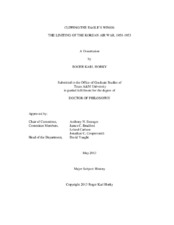| dc.description.abstract | Purpose: This work examines the transition in aerial warfare that took place during the Korean War (1950-1953). Before the conflict, air power was conceived of primarily an instrument of unlimited, or total, warfare. Yet Korea, and all subsequent air wars, have been limited. The transitional nature of the Korean air war has not yet been adequately explored by historians.
Methods: The story of this shift is presented in two parts, the first examining the doctrines of the United States Air Force (USAF) immediately before the Korean War, the second comparing them to the USAF’s actual campaigns in Korea. This focus on the USAF reflects both its status as the principal air service in Korea and its influence on the theories and doctrines of all air arms in the post-World War Two era. The USAF’s planning immediately before the Korean War focused on its role in a possible total war between the United States and the Soviet Union. It was thus unprepared and ill-equipped for the limited war in Korea and had to improvise its operations there.
Findings: The inability of the USAF to conduct an unlimited war in Korea frustrated many Americans, who could not understand the political considerations that limited the conflict, seeing only that the USAF, the world’s most powerful air arm, was prevented from using all of its resources. While the resulting controversy contributed to a change of administration in the United States, it had less of an effect on the USAF. After the Korean War ended, its leadership continued to focus on unlimited war, dismissing the conflict as an aberration from which little about the operation of aircraft in war could be learned.
Conclusions: The failure to recognize the lessons of the Korean War has had serious consequences. There have been no total wars since 1945; every air war of the past sixty years has been limited. Limited warfare is defined by restrictions on air power. The USAF and other air arms were slow to adapt to the changing conditions. The Korean War was a more significant event in the history of aerial warfare than is generally appreciated. | en |


